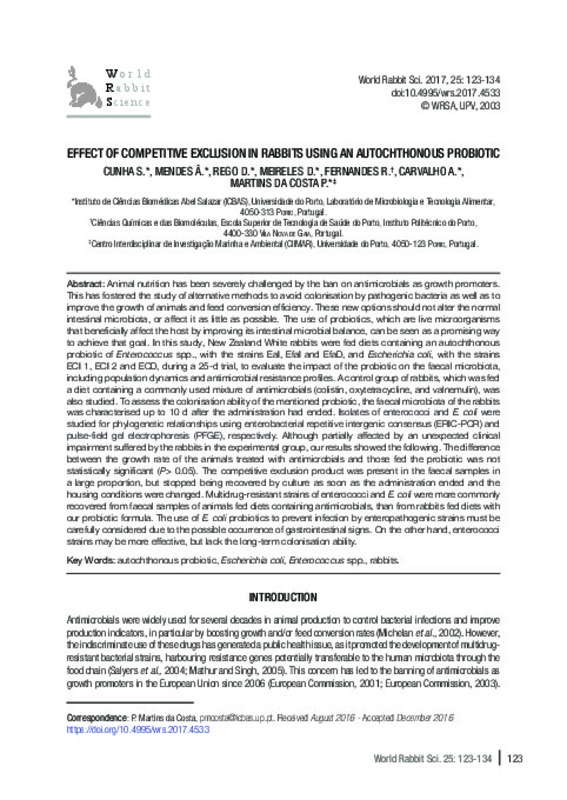JavaScript is disabled for your browser. Some features of this site may not work without it.
Buscar en RiuNet
Listar
Mi cuenta
Estadísticas
Ayuda RiuNet
Admin. UPV
Effect of competitive exclusion in rabbits using an autochthonous probiotic
Mostrar el registro sencillo del ítem
Ficheros en el ítem
| dc.contributor.author | Cunha, Sara
|
es_ES |
| dc.contributor.author | Mendes, Ângelo
|
es_ES |
| dc.contributor.author | Rego, Dinis
|
es_ES |
| dc.contributor.author | Meireles, Diana
|
es_ES |
| dc.contributor.author | Fernandes, Ruben
|
es_ES |
| dc.contributor.author | Carvalho, André
|
es_ES |
| dc.contributor.author | Martins da Costa, Paulo
|
es_ES |
| dc.date.accessioned | 2017-07-10T07:42:09Z | |
| dc.date.available | 2017-07-10T07:42:09Z | |
| dc.date.issued | 2017-06-28 | |
| dc.identifier.issn | 1257-5011 | |
| dc.identifier.uri | http://hdl.handle.net/10251/84799 | |
| dc.description.abstract | [EN] Animal nutrition has been severely challenged by the ban on antimicrobials as growth promoters. This has fostered the study of alternative methods to avoid colonisation by pathogenic bacteria as well as to improve the growth of animals and feed conversion efficiency. These new options should not alter the normal intestinal microbiota, or affect it as little as possible. The use of probiotics, which are live microorganisms that beneficially affect the host by improving its intestinal microbial balance, can be seen as a promising way to achieve that goal. In this study, New Zealand White rabbits were fed diets containing an autochthonous probiotic of Enterococcus spp., with the strains EaI, EfaI and EfaD, and Escherichia coli, with the strains ECI 1, ECI 2 and ECD, during a 25-d trial, to evaluate the impact of the probiotic on the faecal microbiota, including population dynamics and antimicrobial resistance profiles. A control group of rabbits, which was fed a diet containing a commonly used mixture of antimicrobials (colistin, oxytetracycline, and valnemulin), was also studied. To assess the colonisation ability of the mentioned probiotic, the faecal microbiota of the rabbits was characterised up to 10 d after the administration had ended. Isolates of enterococci and E. coli were studied for phylogenetic relationships using enterobacterial repetitive intergenic consensus (ERIC-PCR) and pulse-field gel electrophoresis (PFGE), respectively. Although partially affected by an unexpected clinical impairment suffered by the rabbits in the experimental group, our results showed the following. The difference between the growth rate of the animals treated with antimicrobials and those fed the probiotic was not statistically significant (P> 0.05). The competitive exclusion product was present in the faecal samples in a large proportion, but stopped being recovered by culture as soon as the administration ended and the housing conditions were changed. Multidrug-resistant strains of enterococci and E. coli were more commonly recovered from faecal samples of animals fed diets containing antimicrobials, than from rabbits fed diets with our probiotic formula. The use of E. coli probiotics to prevent infection by enteropathogenic strains must be carefully considered due to the possible occurrence of gastrointestinal signs. On the other hand, enterococci strains may be more effective, but lack the long-term colonisation ability. | es_ES |
| dc.language | Inglés | es_ES |
| dc.publisher | Universitat Politècnica de València | |
| dc.relation.ispartof | World Rabbit Science | |
| dc.rights | Reserva de todos los derechos | es_ES |
| dc.subject | Autochtonous probiotic | es_ES |
| dc.subject | Escherichia coli | es_ES |
| dc.subject | Enterococcus spp. | es_ES |
| dc.subject | Rabbits | es_ES |
| dc.title | Effect of competitive exclusion in rabbits using an autochthonous probiotic | es_ES |
| dc.type | Artículo | es_ES |
| dc.date.updated | 2017-07-10T07:28:54Z | |
| dc.identifier.doi | 10.4995/wrs.2017.4533 | |
| dc.rights.accessRights | Abierto | es_ES |
| dc.description.bibliographicCitation | Cunha, S.; Mendes, Â.; Rego, D.; Meireles, D.; Fernandes, R.; Carvalho, A.; Martins Da Costa, P. (2017). Effect of competitive exclusion in rabbits using an autochthonous probiotic. World Rabbit Science. 25(2):123-134. https://doi.org/10.4995/wrs.2017.4533 | es_ES |
| dc.description.accrualMethod | SWORD | es_ES |
| dc.relation.publisherversion | https://doi.org/10.4995/wrs.2017.4533 | es_ES |
| dc.description.upvformatpinicio | 123 | es_ES |
| dc.description.upvformatpfin | 134 | es_ES |
| dc.type.version | info:eu-repo/semantics/publishedVersion | es_ES |
| dc.description.volume | 25 | |
| dc.description.issue | 2 | |
| dc.identifier.eissn | 1989-8886 |








